Warehouse Process : In the web of supply chain management, warehouses act as vital nodes where goods are stored, organized and distributed. The efficiency and effectiveness of warehouse processes is fundamental to the success of businesses in a variety of industries. Understanding the importance of these processes highlights their indispensable role in enhancing operational excellence and meeting customer demands.
- Topics covered in the Warehouse Process: –
- Inbound Receipt Process: Streamlining Warehouse Operations
- Introduction to Warehouse Inbound Process: –
- Importance of Inbound Receiving:
- Efficiency in Motion: Understanding the Goods Put Away Process
- Efficiency Unveiled: The Process of Order Picking and Packing
- Carefully Sealed: Order Packing Process
- Navigating the Waves of Success: The Outbound Shipping Process
- Mastering the Art of Inventory Management: The Process of “Stock Control”
- Navigating the Path Back: The Art of Return Processing
- Mastering Excellence: The Quality Control Process
- Precision in motion: cycle counting process
- Efficiency uncovered: cross-docking process
- The Craft of Precision: Assembly and Kitting Process
- Frequently Asked Questions:
- What is the warehouse process?
- Why are warehouse processes important?
- What are the major components of warehouse processes?
- How can warehouse processes be optimized?
- What are some common challenges in warehouse processes?
- How can technology improve warehouse processes?
- What are some best practices for warehouse process management?
- How can businesses measure the effectiveness of their warehouse processes?
- What role does security play in warehouse processes?
- How can businesses adapt warehouse processes to meet changing customer demands?
Topics covered in the Warehouse Process: –
Receiving Process: “Inbound Receiving”
Put-Away Process: “Goods Put-Away”
Order Picking Process: “Order Fulfilment” or “Picking and Packing”
Packing Process: “Order Packing” or “Pack and Ship”
Shipping Process: “Outbound Shipping”
Inventory Management Process: “Stock Control” or “Inventory Tracking”
Returns Processing: “Return Handling” or “Reverse Logistics”
Quality Control Process: “Quality Inspection” or “Quality Assurance”
Cycle Count Process: “Inventory Audit” or “Stock Reconciliation”
Cross-Docking Process: “Cross-Dock Operations”
Kitting and Assembly Process: “Assembly and Kitting”
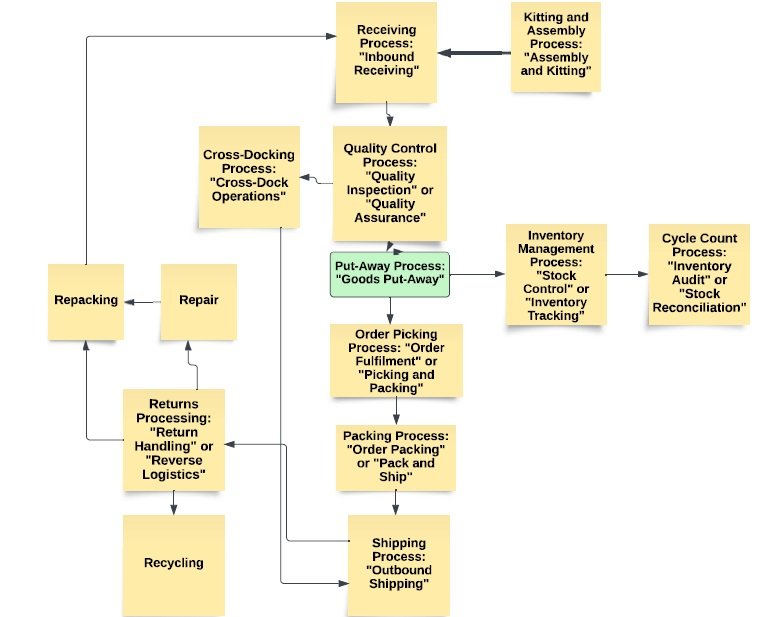
Inbound Receipt Process: Streamlining Warehouse Operations
Introduction to Warehouse Inbound Process: –
The inbound process, often referred to as “receiving”, is a critical component of warehouse operations. It serves as the gateway through which goods enter the warehouse, and its productivity has a deep impact on the entire supply chain. This process involves the physical acceptance of goods from suppliers, their inspection, and then storing these goods within the warehouse. Here, we highlight the importance, key steps, and best practices associated with the inbound receiving process.
Importance of Inbound Receiving:
Efficient inbound receipts are essential for several reasons:
Inventory accuracy:
Receiving ensures that inventory records match actual items received. This accuracy is critical for order fulfillment and maintaining optimal stock levels.
Quality Control:
This process involves inspecting goods for damage, quantity discrepancies, or other quality issues. This helps identify and resolve problems early, preventing defective products from reaching customers.
Speed to market:
Efficient procurement results in faster turnover of products, reducing lead times and enabling quicker delivery to customers.
Cost Efficiency:
Well-executed receiving processes reduce the need for additional storage space and reduce the risk of overstocking, ultimately reducing operating costs.
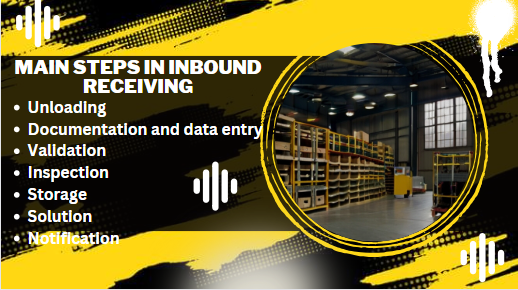
Main Steps in Inbound Receiving:
Unloading:
Goods usually arrive at the warehouse via trucks and are unloaded. It is important to handle items carefully to prevent damage.
Documentation and data entry:
All relevant information about incoming shipments, including packing slips, bills of lading, and purchase orders, is entered. This serves as the basis for data validation.
Validation:
The received items are compared with the provided documentation. This step ensures that the shipment matches the order in terms of quantity and specifications.
Inspection:
A thorough inspection is done to check for any damages, defects, or anomalies. Any issues are documented for possible returns or claims against suppliers.
Storage:
Once verified and inspected, the goods are appropriately stored at their designated locations within the warehouse.
Solution:
Inventory records are updated to accurately reflect the items received. Any discrepancies are resolved.
Notification:
Notifications can be sent to relevant stakeholders, such as purchasing departments or inventory managers, to keep them informed about goods received.
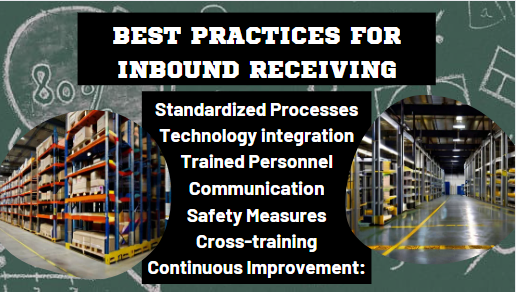
Best Practices for Inbound Receiving:
Standardized Processes:
Clearly defined, documented, and standardized receiving processes help ensure consistency and accuracy.
Technology integration:
Implementing barcode scanning and inventory management software can significantly increase accuracy and efficiency.
Trained Personnel:
Employees involved in the receiving process must be well-trained and knowledgeable about the products they handle.
Communication:
Effective communication between the receiving team and other departments is essential to resolve any issues promptly.
Safety Measures:
Ensuring the safety of personnel during unloading and handling of goods is of supreme importance.
Cross-training:
Cross-training employees to handle different types of products, reducing dependence on specific individuals.
Continuous Improvement:
Regularly review and optimize the process achieved to identify areas of improvement and increase efficiency.
Efficiency in Motion: Understanding the Goods Put Away Process
In the field of warehousing and logistics, the process of placing goods, often referred to as “put-away”, is a critical step in ensuring the uninterrupted flow of products within a warehouse. This often overlooked process plays a vital role in inventory management, warehouse organization, and overall efficiency of operations. We will discuss in detail the importance of the baggage handling process, its key elements, and best practices to ensure a streamlined operation.
Importance of goods put away process:
The warehouse process may not grab the headlines, but it is the backbone of a well-functioning warehouse. Here are some key reasons why this is so important:
Optimal Space Utilization:
Efficient put-away ensures that products are stored in the right place, utilizing the available space to its maximum potential. This helps in reducing storage costs and maximizing warehouse capacity.
Inventory Accuracy:
Proper placement of items during stocking ensures that they are in the correct location, reducing the chance of items being lost or misplaced. This, in turn, leads to higher inventory accuracy.
Quick retrieval:
Placing items in logical locations means they can be retrieved quickly when needed, reducing order fulfillment times and improving customer satisfaction.
Efficiency:
An organized put-away process streamlines operations, reducing the time and effort required to locate and retrieve items. This reduces congestion and traffic within the warehouse.
Key elements of the goods removal process:
Receiving transition:
Put-away often begins immediately after the goods are received. Items need to be moved from the receiving area to their designated storage locations.
Location Assignment:
An important step is to determine where each item should be stored. This requires a well-designed location system, often based on factors such as item type, size, demand, and turnover rate.
Transportation and Handling:
Once the location is determined, the goods are moved from the receiving area to their storage locations. This may include various handling equipment ranging from forklifts to conveyors, depending on the nature of the goods.
Verification:
It is important to double-check that items are placed in the correct locations. Barcoding and scanning technology can be used to ensure accuracy.
Updating Records:
Inventory management systems need to be updated to reflect the new location of items. This step is important for accurate tracking and efficient order selection.
Best Practices for Easier Capturing Process:
Prioritize space allocation:
Consider your warehouse layout and storage systems. Specify space based on the frequency of item retrieval and storage capacity.
Slotting Optimization:
Regularly review and adjust the slotting of items to ensure the most frequently selected items are easily accessible.
Standardized Procedures:
Develop and maintain standard operating procedures for the put-away process. This ensures consistency and reduces errors.
Training and qualifications:
Ensure that staff responsible for put-away are well trained in handling a variety of products and using handling equipment safely.
Regular Audits:
Periodic audits and cycle counts help identify discrepancies and maintain inventory accuracy.
Leverage technology:
Use warehouse management systems (WMS) and inventory management software to streamline and automate the put-away process.
Efficiency Unveiled: The Process of Order Picking and Packing
In the world of warehousing and e-commerce, the order-picking process is the heartbeat of order fulfillment. Sometimes referred to as “order fulfillment” or “picking and packing,” This is the process, which plays an important role in accurately product reaching customers. The particulars of the order picking and packing process, its vital role in customer satisfaction, and best practices for optimizing it.
Important Role of Order Picking and Packing:
The order picking and packing process is at the core of the warehouse’s daily operations. This is important for several reasons:
Customer Satisfaction:
Timely and accurate order fulfillment is essential to meet customer expectations. A well-executed process leads to happy customers and repeat business.
Operational Efficiency:
Efficient order picking and packing minimizes labor and storage costs while maximizing throughput. This ensures that resources are optimally utilized.
Inventory Accuracy:
This process is essential to maintaining accurate inventory records. When items are correctly picked, packed, and shipped, inventory stays in sync.
Cost Control:
Reducing errors in the process can prevent costly returns and reshipments. It also streamlines the entire supply chain.
Main components of the order picking and packing process:
Order Retrieval:
The process starts with the retrieval of customer orders from the order management system or warehouse management system (WMS).
Picking:
This step involves selecting the listed items in order from their storage locations. Different picking methods exist, including batch picking, zone picking, and wave picking, each suitable for different warehouse layouts and order profiles.
Verification:
After selecting, it is necessary to verify that the correct items and quantities have been selected. This can be done manually or with the help of technology like barcode scanners.
Packing:
Once items are verified, they are packed into proper shipping containers. This can range from standard boxes to custom packaging depending on the items and customer preferences.
Labelling:
Shipping labels, packing slips, and any necessary documentation are prepared and affixed to packages.
Quality Control:
Final checks for accuracy and package integrity are frequently performed to ensure that the customer receives their order in the best possible condition.
Shipping:
Orders are shipped to their respective carriers for delivery to the end customer.
Best Practices for Smooth Order Picking and Packing:
Process Optimization:
Regularly analyze and improve the order-picking process to reduce travel time, improve picking accuracy, and reduce congestion.
Employee Training:
Well-trained employees are more efficient and make fewer mistakes. Investing in training pays off in terms of accuracy and speed.
Automation and technology:
Use technology like barcode scanners, RFID systems, and order management software to streamline processes and reduce errors.
Dynamic slotting:
Revaluate storage locations based on demand patterns to ensure the most frequently selected items are easily accessible.
Batch Selection:
When appropriate, use batch selection to increase selection efficiency.
Quality Assurance:
Implement quality control checks to catch errors before they become costly problems.
Effective Communication:
Ensure clear communication between departments, from the order management team to the packing team.
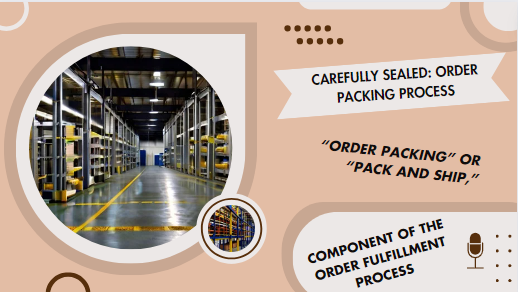
Carefully Sealed: Order Packing Process
Introduction to the Order Packing Process
In the world of e-commerce and retail, the order packing process is the final touch, the last impression of a product before it reaches the customer. This step, known as “order packing” or “pack and ship,” is critical to ensuring that items are safely and cleanly prepared for delivery. The details of the order packing process, its vital role in customer satisfaction, and the best practices to achieve perfection in this often overlooked stage.
Important Role of Order Packing:
Order packing is more than filling products into a box; it is a strategic and important component of the order fulfillment process. Here’s why this is so important:
Customer Experience:
The condition in which the customer receives their package significantly impacts their observation of the brand. A well-packaged order reflects professionalism and care, leading to higher customer satisfaction and repeat business.
Damage Prevention:
Properly packing items ensures that they arrive in original condition. This reduces the risk of damage during transit, reducing costly returns and customer complaints.
Efficiency and cost control:
Efficient packing methods save time and materials, reducing packing and shipping costs.
Sustainability:
Environmentally conscious consumers appreciate sustainable packaging practices, such as using recyclable materials and right-sized boxes.
Key elements of the order packing process:
Selecting packaging materials:
The process begins with selecting appropriate packaging materials, including boxes, bubble wrap, packing paper, and other protective materials.
Product Handling:
Products are carefully placed in packaging to prevent their movement during transportation and reduce the risk of damage. This often involves the use of dividers or void filler materials.
Documentation:
Packing slips and invoices are included in the package, ensuring the customer receives the necessary information.
Sealing and Labeling:
The package is securely sealed, and shipping labels are attached along with any required customs documentation.
Quality Control:
Final checks are performed to ensure that all items are included, packaging is secure and labels are correct.
Weights and Measures:
Packages are weighed and measured to determine shipping costs and ensure compliance with carrier specifications.
Shipping:
Finally, the package is handed over to the chosen carrier for delivery to the customer.

Best Practices for Flawless Order Packing:
Packaging Selection:
Select the correct packaging for the item being shipped. Large packaging wastes space and materials, while packaging that is too small can cause damage.
Protective Materials:
Use appropriate protective materials, such as bubble wrap, packing peanuts, or foam inserts, to protect items during transit.
Efficient layout:
Optimize the layout of products in the box to minimize free space and reduce the risk of damage due to movement.
Quality Assurance:
Implement rigorous quality checks to ensure all items are included, and packaging is secure and well-sealed.
Sustainability:
Consider eco-friendly packaging materials and practices to meet the demands of environmentally conscious consumers.
Labeling accuracy:
Make sure shipping labels and documentation are accurate and up to date to avoid delivery issues.
Employee Training:
Train and empower employees to perform their packing duties efficiently and with attention to detail.
Navigating the Waves of Success: The Outbound Shipping Process
Introduction to Outbound Shipping Process:
In the world of e-commerce and supply chain management, the outbound shipping process is the final step in a complex journey that starts with a customer’s order and ends with the delivery of products to their doorstep. Often referred to as “outbound shipping,” this step plays a vital role in customer satisfaction, operational efficiency, and a business’s reputation. In this blog, we will explore the importance of the outbound shipping process, its key components, and best practices to ensure seamless and successful shipments.
Important Role of Outbound Shipping:
Outbound shipping is the bridge between a completed order and a satisfied customer. Here’s why this process is so important:
Customer Satisfaction:
On-time and damage-free delivery is supreme to customer satisfaction. A seamless shipping process positively impacts the brand and encourages repeat business.
Efficiency and cost control:
Effective outbound shipping reduces operating costs, optimizes route planning, and reduces shipping errors, all of which contribute to better cost control.
Inventory Management:
Shipping is closely linked to inventory management, as the efficient release of products from the warehouse depends on accurate shipping procedures.
Brand reputation:
Shipping is often the last interaction a customer has with a business. A seamless experience reinforces the company’s reputation for reliability and professionalism.
Key Elements of the Outbound Shipping Process:
Order Preparation:
Orders are collected and prepared for shipping. This includes picking and packing items, preparing shipping labels, and making sure all documents are in order.
Carrier Selection:
Choosing the right carrier is important. This decision depends on factors such as destination, shipping method, cost, and type of products being shipped.
Labeling and Documentation:
Shipping labels are prepared and attached to packages. Depending on the nature of the shipment additional documentation, such as packing slips, customs forms or invoices may also be included.
Weights and Measures:
Packages are weighed and measured to determine shipping costs and ensure compliance with carrier requirements.
Quality Control:
Final checks are performed to verify that all items are included, packaging is secure and labels are accurate.
Loading and Dispatch:
Packages are loaded onto the chosen carrier’s vehicle for delivery. Depending on the arrangement this may be a postal service, a private courier, or a shipping company.
Route Planning and Tracking:
Efficient route planning ensures timely delivery. Shipment tracking is often available to both the business and the customer, providing real-time updates on the progress of deliveries.
Delivery Confirmation:
Once a package has been delivered, delivery confirmation is often received and recorded.
Best Practices for Smooth Outbound Shipping:
Carrier selection:
Choose the carrier based on factors such as destination, delivery time, cost, and nature of products. Evaluate carrier performance regularly.
Labelling Efficiency:
Use a label generation system that integrates with your order management system to ensure accurate and efficient label printing.
Automated Shipment Tracking:
Implement automated tracking and alert systems to keep customers informed about the status of their deliveries.
Inventory accuracy:
Regularly update inventory records to reflect items shipped, which helps avoid overcommitting stock.
Quality Assurance:
Make sure all packages are checked for accuracy and safety before being shipped, reducing the chance of errors.
Sustainability:
Consider eco-friendly packaging materials and route optimization to reduce the environmental impact of shipping operations.
Employee Training:
Train employees in efficient shipping processes and keep them updated on industry best practices.
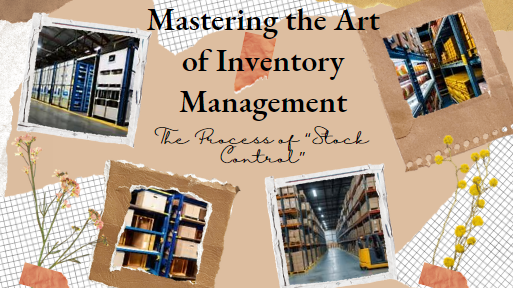
Mastering the Art of Inventory Management: The Process of “Stock Control”
Introduction to Stock Control:
In the world of supply chain management, the process of “stock control”, also commonly known as “inventory tracking”, is the heartbeat of efficient operations for businesses. It involves an organized approach to managing a company’s inventory, ensuring that it remains at optimal levels to meet customer demands while reducing costs and wastage. The details of the inventory management process, the importance of stock control, and best practices to keep operations running seamlessly.
Importance of Stock Control:
Inventory is often one of the largest assets for a business, and how it is managed has a deep impact on the bottom line. Here’s why stock control is so important:
Cost optimization:
Maintaining the correct level of inventory can prevent overstocking, which ties up capital, or understocking, which can lead to lost sales. Efficient stock control helps in reducing carrying costs and improving profitability.
Customer Satisfaction:
Keeping enough stock to meet customer demands ensures that products are available when needed. This increases customer satisfaction and loyalty.
Operational Efficiency:
Accurate and efficient stock control reduces the need for manual intervention, streamlines order fulfillment, and reduces errors.
Waste Reduction:
Effective stock control reduces the risk of obsolete or expired inventory, reducing waste and disposal costs.
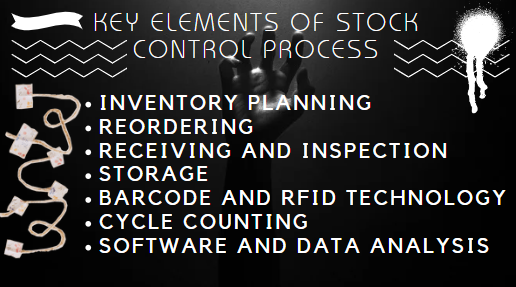
Key Elements of Stock Control Process:
Inventory Planning:
This step involves forecasting demand based on historical data, seasonality, and market trends. This helps to determine how much stock is required for each product.
Reordering:
Once the inventory level falls below a predetermined limit, reordering / replenishment begins. The reorder point is often calculated based on the lead time for restocking and the expected demand during that time.
Receiving and Inspection:
Upon receipt of new inventory, it is carefully inspected to verify that the delivered products match the order, are in good condition, and are of the expected quality.
Storage:
Stock is kept at appropriate storage locations depending on factors such as type of product, demand, and spoilage.
Barcode and RFID technology:
The use of barcode scanners and RFID (radio-frequency identification) systems can significantly improve the accuracy of tracking and reduce the risk of errors.
Cycle counting:
Regular cycle counting involves counting a subset of items in inventory each day, ensuring that discrepancies are identified and addressed promptly.
Software and data analysis:
Advanced inventory management software helps track and analyze stock levels, order history, and demand patterns.
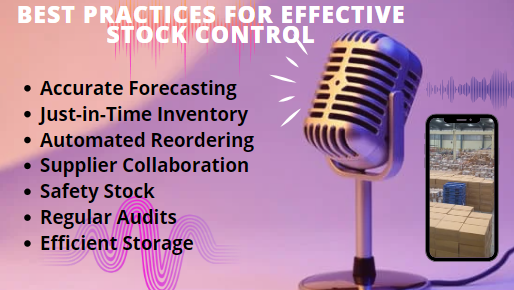
Best Practices for Effective Stock Control:
Accurate Forecasting:
Use historical data, market analysis, and industry trends for accurate demand forecasting.
Just-in-Time Inventory:
Consider the just-in-time (JIT) approach, which reduces costs by ordering inventory only as needed.
Automated Reordering:
Implement an automated reordering system to prevent stockouts and overstocking.
Supplier Collaboration:
Maintain effective communication with suppliers to ensure timely and accurate delivery.
Safety Stock:
Keep a safe stock to avoid unexpected fluctuations in demand or supply chain disruptions.
Regular Audits:
Perform regular cycle counts and audits to maintain accurate inventory records and identify and resolve discrepancies.
Efficient Storage:
Implement organized and efficient storage systems to reduce the risk of lost or misplaced items.
Navigating the Path Back: The Art of Return Processing
Introduction to Return Processing:
Returns processing, often referred to as “returns handling” or “reverse logistics”, is a critical aspect of the supply chain that is often influenced by the excitement of sales and order fulfillment. However, this process is essential to maintain customer satisfaction, manage product returns, and minimize losses. The details of returns processing, its importance, and best practices to effectively manage the flow of goods in the reverse direction.
Importance of Returns Processing:
Returns are an essential part of the retail landscape, and how they are managed can have a significant impact on a business. Here’s why returns processing is so important:
Customer Satisfaction:
An efficient and hassle-free returns process increases customer satisfaction, leading to loyalty and positive word-of-mouth recommendations.
Inventory Management:
Returns require careful management of returned products, ensuring they can be resold or processed correctly.
Cost Control:
Effective returns processing reduces losses associated with returned goods and can lead to savings through improved operational efficiency.
Environmental responsibility:
Reverse logistics plays an important role in sustainability efforts, helping to reduce waste and environmental impact.
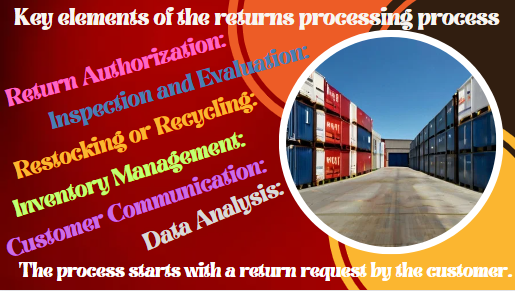
Key elements of the returns processing process:
Return Authorization:
The process starts with a return request by the customer. The request is usually evaluated, and if approved, a return authorization is issued.
Inspection and Evaluation:
When a returned item is received, it is inspected to determine its condition. Is it in resalable condition, or is it in need of repair, renovation, or disposal?
Restocking or Recycling:
Goods that are in resalable condition can be restocked for resale. Items that require repair or renovation are sent to the appropriate department, while items that cannot be resold can be recycled or disposed of.
Inventory Management:
Managing items returned to inventory is essential to ensure that they are correctly classified and accounted for.
Customer Communication:
Keeping the customer informed throughout the process is important for transparency and customer satisfaction.
Data Analysis:
Regularly analyzing return data can help identify trends and areas for improvement, which may reduce the overall rate of return.
Best Practices for Effective Returns Processing:
Clear Returns Policy:
A well-defined and transparent returns policy sets expectations for customers and streamlines the returns process.
Efficient management:
Streamline the returns process to reduce time spent inspecting, evaluating, and restocking or recycling returned items.
Customer communications:
Keep customers informed at every step of the returns process to reduce concern and build trust.
Quality Control:
Implement rigorous quality checks to ensure that restocked items meet the same quality standards as new products.
Inventory accuracy:
Update inventory records to accurately reflect the condition and location of returned items.
Data Analytics:
Regularly analyze return data to identify patterns or issues that can be addressed to reduce future returns.
Recycling and sustainability:
Consider recycling and sustainability efforts for items that cannot be restored to reduce waste and environmental impact.
Mastering Excellence: The Quality Control Process
Introduction to Quality Control Process
In the field of manufacturing and production, the quality control process, sometimes called “quality inspection” or “quality assurance”, serves as a steadfast guardian of product quality and customer satisfaction. It is a careful and systematic approach to ensure that products meet defined standards and conform to the highest levels of quality. The importance of the quality control process, its essential components, and best practices that help maintain the highest standards of product excellence.
Importance of Quality Control:
The importance of quality control cannot be underestimated, as it directly impacts product performance, customer satisfaction, and brand reputation. Here’s why the quality control process is so important:
Customer Satisfaction:
Higher quality products result in satisfied customers who are more likely to become brand loyal, advocate for the product, and make repeat purchases.
Risk Mitigation:
Ensuring product quality can reduce the risk of defects, safety issues, and recalls, which can have serious financial and reputational consequences.
Operational Efficiency:
Implementing quality control procedures improves operational efficiency by reducing the number of defects, rework, and wastage.
Compliance and Regulation:
Quality control is often necessary to comply with industry standards and regulations, ensuring that products meet legal requirements.

Key Elements of Quality Control Process:
Quality Plan:
Before production begins, a quality plan is developed, outlining quality criteria, standards, and specific inspection points.
In-Process Inspection:
During the manufacturing process, quality control professionals perform inspections at various stages to ensure compliance with defined quality norms.
Random Sampling:
Random samples of produced goods are frequently inspected to identify defects or variations in quality.
Testing and measurement:
Quality control may include various testing and measurement methods, such as dimensional measurement, strength testing, and material analysis.
Visual Inspection:
Visual inspection plays an important role, especially in assessing product surface quality.
Documentation:
Quality control processes typically include extensive record-keeping to document inspections, abnormalities, and corrective actions.
Defect Identification:
When defects are found, a process is established to identify, classify, and resolve these issues. This may include quarantine, repair, or disposal of affected products.
Best Practices for Effective Quality Control:
Clear quality standards:
Ensure that quality standards and criteria are well-defined and communicated to all concerned parties.
Staff training:
Train quality control professionals to conduct inspections effectively and consistently, keeping them up to date on industry standards and best practices.
Technology integration:
Use advanced technology, such as automation, robotics, and data analytics, to increase the accuracy and efficiency of quality control processes.
Risk Management:
Implement risk management systems to quickly identify potential quality issues and take preventive measures.
Regular Audits:
Regularly audit the quality control process to identify areas for improvement and maintain compliance.
Corrective action plans:
Establish a robust system to address identified defects, including determining the root cause, implementing corrective actions, and verifying their effectiveness.
Customer Feedback:
Collect and analyze customer feedback to identify quality issues and make necessary improvements.
Precision in motion: cycle counting process
Introduction of Cycle Counting Process:
In the world of inventory management, the cycle count process, sometimes called an “inventory audit” or “stock reconciliation”, serves as a vital tool for maintaining accurate and up-to-date inventory records. It is a systematic approach to regularly counting and verifying a subset of inventory items, which helps reduce discrepancies and ensure that inventory reflects the actual quantity on hand. The importance of the cycle count process, its key components, and best practices that contribute to seamless and accurate management of inventory.
Importance of Cycle Counting Process:
The accuracy of inventory records is critical for efficient supply chain operations, customer satisfaction, and financial management. Here’s why the cycle count process is so important:
Inventory Accuracy:
The cycle count process is the foundation of inventory accuracy. Regular counting helps detect and correct discrepancies, reducing the risk of overstock or stockouts.
Operational efficiency:
Accurate inventory records lead to more efficient order fulfillment, less manual intervention, and lower carrying costs.
Cost Control:
Fewer discrepancies result in less shrinkage and lower carrying costs, which ultimately contribute to cost control.
Customer Satisfaction:
When inventory is managed correctly, customers receive their orders on time, which increases customer satisfaction.
Key elements of the cycle counting process:
Count Plan Development:
A count plan is established, detailing which items will be counted, how often, and in what order. High-value or high-demand items may be given priority.
Calculation Execution:
Cycle calculations are performed regularly, with calculations executed on a specific subset of objects during each cycle.
Count Verification:
Counts are verified to identify discrepancies and match them with inventory records. This may involve the use of barcode scanners, RFID technology, or manual counting.
Root cause analysis:
If differences are found, root cause analysis is performed to determine why they occurred. This helps in implementing preventive measures.
Corrective actions:
When discrepancies are identified, corrective actions are initiated to correct the inventory records and address the root cause of the problem.
Documentation:
Comprehensive documentation is maintained throughout the cycle calculation process, including calculation results, discrepancies, corrective actions, and validations.
Best Practices for Effective Cycle Count:
Regular scheduling:
Establish a consistent schedule for cycle counting, ensuring that all items are counted timely and that higher-priority items are counted more frequently.
Random sampling:
Apply random sampling to prevent expectedness and ensure a more accurate representation of inventory.
Cycle counting teams:
Train and assign specific teams or individuals to cycle counting tasks, ensuring they are well-versed in the process.
Technology integration:
Leverage inventory management software, barcode scanners, and RFID technology to streamline and increase cycle count accuracy.
Root cause analysis:
Focus on understanding the reasons behind anomalies and implementing preventive measures to reduce future differences.
Continuous improvement:
Regularly review the cycle count process and make improvements based on data analysis and feedback.
Documentation
Excellence: Maintain complete and accurate documentation of the cycle count process, ensuring that records are accessible and easily auditable.
Efficiency uncovered: cross-docking process
Introduction to Cross Docking Process:
In the dynamic world of logistics and supply chain management, cross-docking operations stand as a height of efficiency, transforming the way goods are sorted, routed, and delivered. This process, known simply as “cross-docking,” is a game-changer in streamlining the flow of products from suppliers to customers, eliminating the need for extensive warehousing and reducing handling times. The importance of the cross-docking process, its key components, and the best practices that make it a powerhouse in the world of logistics.
Importance of Cross-docking:
Cross-docking is a logistics strategy that involves transferring goods directly from inbound to outbound transportation, with little or no storage in between. The importance of cross-docking is evident in several key aspects:
Less handling:
Cross-docking reduces the time and handling required for goods, thereby reducing the risk of damage, delays, and associated costs.
Efficient distribution:
It optimizes the distribution process, allowing products to be sorted faster and sent to their respective destinations.
Inventory control:
Cross-docking reduces the need for long-term storage, reducing inventory holding costs and the risk of overstock or obsolescence.
Just-in-Time (JIT) Fulfillment:
It supports the JIT concept, enabling companies to deliver goods immediately to meet customer demands by avoiding receiving and storing goods.
Key elements of the cross-docking process:
Receiving and unloading:
Incoming shipments are received at a cross-docking facility, and the goods are unloaded directly from the arriving transport.
Sorting and Processing:
Goods are sorted and processed according to their destination. This may include labeling, packaging adjustments, and quality checks.
Temporary storage:
In some cases, products may be stored temporarily, but only for a minimum period as they await outbound transportation.
Outbound Loading:
After sorting, the products are immediately loaded onto outbound transportation, ensuring that they reach their final destination promptly.
Inventory Control:
Real-time inventory tracking and management play a vital role in coordinating the cross-docking process.

Best practices for effective cross-docking:
Strategic planning:
Develop a well-structured plan for cross-docking operations, including a clear understanding of which products are suitable for cross-docking and which are not.
Effective Communication:
Seamless communication between suppliers, cross-docking facilities, and customers is essential for accurate scheduling and coordination.
Technology integration:
Use modern technologies such as barcode scanning, RFID systems, and inventory management software to increase the speed and accuracy of cross-docking processes.
Quality Control:
Implement quality checks to ensure products are received and shipped in optimal condition.
Skilled Workforce:
Train employees for efficient handling and sorting of products to reduce errors and delays.
Real-time visibility:
Maintain real-time visibility into inventory and shipping processes to adjust strategies and respond quickly to unexpected issues.
Partner Collaboration:
Collaborate with suppliers and carriers to optimize the supply chain and ensure products arrive at the cross-docking facility at the right time and in the right quantity.
The Craft of Precision: Assembly and Kitting Process
Introduction to Assembly and Kitting Process:
In the complex world of manufacturing, the assembly and kitting process serves as an art that brings together individual components to create a functional product or package. This process, known simply as “assembly and kitting,” is essential in industries ranging from electronics and automotive to retail and e-commerce, where products are often composed of multiple parts or bundled together for efficient distribution. The importance of the assembly and kitting process, its key components, and best practices that contribute to accuracy and efficiency.
Importance of Assembly and Kitting:
Assembly and kitting are fundamental processes in manufacturing and distribution, affecting various aspects of the industry. Here’s why the assembly and kitting process is so important:
Product Customization:
It allows product customization by combining different components to meet specific customer requirements.
Efficient Packaging:
Kitting enables efficient packaging of products, reducing the time and cost of picking individual items.
Quality Control:
Assembly processes systematically verify the accuracy of each component to ensure that products meet quality standards.
Inventory Management:
Kitting helps manage inventory by bundling and tracking components and finished products more effectively.
Key elements of the assembly and kitting process:
Component Selection:
The process begins with the selection of individual components that will be assembled or put together to create a finished product or package.
Assembly Plan:
Detailed assembly plans are developed to outline the sequence and functioning of the assembly of components. This includes defining the workstation, tools, and quality control steps.
Component Inspection:
Each component is inspected to ensure that it meets the quality standards required for assembly. Damaged or substandard components may be rejected.
Kitting or Assembly:
The actual process of assembling components. This can involve anything from assembling a complex electronic device to creating a bundled package of products for a customer’s order.
Quality Control:
Quality checks are performed during the assembly and kitting process to verify that each step is performed correctly and that the final product meets quality standards.
Packaging and Labelling: After assembly or kitting, finished products are appropriately packaged and labeled for tracking, shipping, or customer identification.
Best Practices for Effective Combining and Kitting:
Comprehensive Planning:
Develop detailed assembly and kitting plans, clearly outlining steps, materials, and quality control measures.
Skilled workforce:
Train employees in specific assembly or kitting processes to reduce errors and ensure efficiency.
Quality Control:
Implement rigorous quality checks at each stage of assembly to quickly catch and resolve defects.
Technology integration:
Use technology such as barcode scanners, RFID systems, and assembly software to increase the accuracy and efficiency of assembly and kitting processes.
Flexible Workstations:
Design workstations that can be easily adapted to different assembly or kitting processes, allowing efficient switching between products.
Lean Principles:
Adopt lean manufacturing principles to reduce waste, improve efficiency, and optimize resource utilization.
Supplier Collaboration:
Collaborate with suppliers to ensure a continuous supply of high-quality components for assembly and kitting.
Conclusion:
The inbound receiving process is the foundation of efficient warehouse management. It ensures the accuracy of inventory records, quality control, and quick access to products. By following best practices and optimizing this process, warehouses can maintain a competitive edge in a fast-paced and customer-centric supply chain environment. Accurate and efficient inbound receiving sets the stage for successful warehouse operations and customer satisfaction.
The stocking process may seem like a routine task, but it is also the foundation of a well-run warehouse. Efficiency in this process directly impacts inventory accuracy, order fulfillment speed, and overall operational productivity. By following best practices and optimizing the put-away process, warehouses can ensure that they are not only storing merchandise but also setting the stage for successful and cost-effective operations. This is evidence of the idea that in storage, efficiency is often hidden in the details.
The order picking and packing process is the connection between customer satisfaction, operational efficiency, and inventory accuracy. As e-commerce continues to grow, it is more important than ever to perfect this process. By following best practices and leveraging technology, warehouses can streamline their operations, reduce errors, and ensure customers receive their orders promptly and accurately. In short, it is not just the process of picking and packing, but a key driver of customer loyalty and business success.
The order packing process is not a simple formality; it is the final touch that ensures customer satisfaction, prevents damage, and controls costs. The way the package is prepared and presented reflects the brand’s commitment to quality and professionalism. By following best practices and implementation sustainability, businesses can improve their reputation, reduce returns, and win the loyalty of customers who appreciate the care taken to deliver their orders safely and on time. In short, order packing is not just about putting items in a box but about sending a message of trust and reliability.
the outbound shipping process is the bridge that connects businesses to their customers. It is a critical stage in the order fulfillment process that has a direct impact on customer satisfaction, operational efficiency, and brand reputation. By following best practices and leveraging technology for route planning and tracking, businesses can ensure that their customers receive their orders on time and in good condition. Outbound shipping isn’t just about sending products; it’s about delivering on the promise of reliability and professionalism, which ultimately leads to customer loyalty and business success.
stock control, or inventory tracking, is the backbone of efficient supply chain management. It affects the company’s profitability, customer satisfaction, and operational efficiency. By following best practices and leveraging technology for tracking and data analysis, businesses can maintain optimal inventory levels, reduce costs, and minimize waste. Stock control is not just about counting items on the shelves; It’s about optimizing operations and ensuring products are available when and where they are needed, ultimately leading to customer loyalty and a healthy profit.
returns processing, often referred to as returns handling or reverse logistics, is an integral part of the supply chain, impacting customer satisfaction, cost control, and sustainability. By following best practices and maintaining clear communication with customers, businesses can effectively manage returns, minimize losses, and maintain a positive brand image. Returns processing is not just about handling returned items; it is about managing a complex and delicate aspect of business in a way that ultimately drives customer loyalty and environmental responsibility.
the quality control process, whether it is called quality inspection or quality assurance, is the pivot of product excellence and customer satisfaction. It’s the last line of defense against defects, and it sets the standard for what customers can expect from a brand. By following best practices, implementing technology, and maintaining clear quality standards, businesses can create products that not only meet customer expectations but also build a reputation for reliability and excellence. Quality control does not just mean inspecting products; it’s about delivering on the promise of quality, which is the foundation of brand success and customer loyalty.
The cycle count process, whether referred to as an inventory audit or stock reconciliation, is the foundation of inventory accuracy and efficiency. This ensures that inventory records remain reliable and discrepancies are addressed promptly. By following best practices and leveraging technology, businesses can maintain accurate inventory records, reduce carrying costs, and provide timely, error-free order fulfillment. Cycle counting is not just about counting objects; it’s about the constant pursuit of inventory accuracy and the foundation of customer satisfaction and operational excellence.
Cross-docking, or cross-dock operations, is a foundation of efficient supply chain management, providing a surplus of benefits in terms of lean handling, efficient distribution, inventory control, and JIT fulfillment. By following best practices and adopting technology, businesses can streamline their logistics operations, reduce costs, and provide quicker and more reliable service to their customers. Cross-docking is not just a logistics strategy; it is a gateway to unmatched efficiency in the world of distribution and a testament to the industry’s ever-evolving quest for perfection.
the assembly and kitting process, whether it is called kitting or assembly, is a craft of accuracy that shapes the manufacturing and distribution industries. It allows customization, efficient packaging, quality control, and effective inventory management. By following best practices and adopting technology, businesses can streamline their assembly and kitting operations, reduce costs, and ensure that end products meet the highest standards of quality. Assembly and kitting are not simple processes; they are the essence of accuracy and efficiency in the world of manufacturing and distribution, paving the way for product optimization and customer satisfaction.
Click here for more topics
Frequently Asked Questions:
What is the warehouse process?
A warehouse process refers to the series of tasks and activities involved in the storage, management, and distribution of goods within a warehouse facility. These processes include receiving, placing, storing, picking, packing, shipping, and inventory management.
Why are warehouse processes important?
Warehouse processes are essential to optimize inventory management, facilitate timely order fulfillment, reduce operating costs, enable scalability and flexibility, enhance overall supply chain performance, and promote continuous improvement.
What are the major components of warehouse processes?
Major components of warehouse processes include receiving incoming goods, placing them in designated storage locations, picking items to fulfill orders, packing orders for shipment, shipping merchandise to customers, and managing inventory levels.
How can warehouse processes be optimized?
Warehouse processes can be optimized through a variety of means, including implementing efficient workflows, using technology such as barcode scanning and RFID, optimizing storage layout and space utilization, training employees on best practices, and based on performance metrics. Involves regular evaluation and improvement of processes.
What are some common challenges in warehouse processes?
Common challenges in warehouse processes include inventory inaccuracies, inefficient picking and packing processes, labor shortages, poor space utilization, inadequate infrastructure or technology, and lack of visibility and control over inventory activities.
How can technology improve warehouse processes?
The technology helps by automating repetitive tasks, providing real-time visibility into inventory levels and movements, optimizing pick routes, increasing order accuracy through barcode scanning and RFID, and seamlessly integrating with enterprise resource planning (ERP) software like others. Can improve warehouse processes by integrating with systems (data management).
What are some best practices for warehouse process management?
Best practices for warehouse process management include implementing standardized operating procedures, conducting regular employee training and performance reviews, maintaining clean and organized facilities, investing in quality infrastructure and equipment, fostering a culture of continuous improvement, and engaging with stakeholders. Involves actively seeking feedback.
How can businesses measure the effectiveness of their warehouse processes?
Businesses can measure the effectiveness of their warehouse processes by tracking key performance indicators (KPIs) such as order fulfillment rates, inventory accuracy, on-time delivery performance, labor productivity, space utilization, and customer satisfaction metrics.
What role does security play in warehouse processes?
Safety is paramount in warehouse processes to prevent accidents, injuries, and property damage. Businesses should implement comprehensive safety protocols, provide proper training to employees on safe work practices and equipment operation, conduct regular safety inspections, and maintain a culture of safety awareness among all employees.
How can businesses adapt warehouse processes to meet changing customer demands?
Businesses can adapt warehouse processes to meet changing customer demands by implementing agile and flexible workflows, leveraging technology to improve response and order accuracy, and inventory levels to reduce lead times Can adapt and continuously monitor and analyze customer feedback to identify areas of improvement.

Pingback: Warehouse Safety: Best Practices for Secure Work Environment
Pingback: The Role of Vehicles in Streamlining Warehouse Logistics
Pingback: Transportation Management Systems with Innovative Solutions